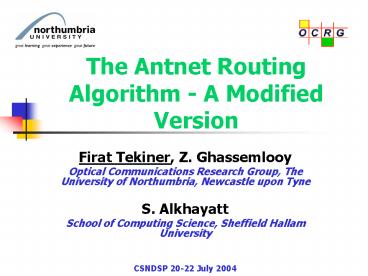The Antnet Routing Algorithm A Modified Version - PowerPoint PPT Presentation
1 / 17
Title:
The Antnet Routing Algorithm A Modified Version
Description:
Optical Communications Research Group, The University of Northumbria, ... protects their nests. Sorts brood and ... paths to their nests or food source ... – PowerPoint PPT presentation
Number of Views:262
Avg rating:3.0/5.0
Title: The Antnet Routing Algorithm A Modified Version
1
The Antnet Routing Algorithm - A Modified Version
- Firat Tekiner, Z. Ghassemlooy
- Optical Communications Research Group, The
University of Northumbria, Newcastle upon Tyne - S. Alkhayatt
- School of Computing Science, Sheffield Hallam
University - CSNDSP 20-22 July 2004
2
Contents
- Background Information
- Ant Colony Optimisation
- Agent Based Routing Algorithms
- Antnet routing algorithm
- Improvements proposed
- Simulation Environment and Results
- Concluding Remarks
3
Aims Objectives
- Designing a routing algorithm
- Scalable
- Distributed
- Intellegent
- Self - Organising
- Fault Tolerant
- Generic Network and Machine Independent
4
Routing
- In internetworking, the process of moving a
packet of data from source to destination. - A routing algorithm is necessary to find the
optimal path (or the shortest path) from source
to destination. - Problems
- Existing algorithms are mostly Table-Based (high
cost) - Congestion and contention (requires traffic
distribution) - Requires human intelligence
- The routing algorithms that are in use are all
static algorithms
5
Classification
- Q-Learning
- Q-routing (Boyan et al, 94) (Tekiner et al., 04)
- Dual reinforcement Q-routing (Kumar et al., 97
01) - Ant (software agent) based Routing Algorithms
- ABC routing (Schoonderwoerd et al., 96)
- Regular and Uniform ant routing (Subramanian et
al., 97) - Antnet (Dorigo et al., 98)
- Antnet (Dorigo et al., 02)
- Improved Antnet (Boyan et al., 02)
- Antnet with evaporation (Tekiner et al. 2, 04)
- Agent Distance Vector Routing (ADVR) (Amin et
al., 01 02)
6
Comparison of Algorithms
- Antnet uses probabilistic routing tables whereas
in Link State and Distance Vector routing table
entries are deterministic - Ants use less resources on the nodes
- Ants are dynamic and self organising whereas
Distance Vector and Link State algorithms require
human supervision - Q-Routing does not guarantee on finding the
shortest path always. Moreover, they can only
find a single path, they cannot explore multiple
paths - In antnet stagnation is the main problem (routing
table freezes due to selecting same path)
7
Ants In Nature - unsophisticated and simple
- Builds and protects their nests
- Sorts brood and food items
- Explore particular areas for food, and
preferentially exploits the richest available
food source - Cooperates in carrying large items
- Migrates as colonies
- Leaves pheromones on their way back
- Stores information in the nature (uses world as a
memory) - Make decision in a stochastic way
- Always finds the shortest paths to their nests or
food source - Are blind, can not foresee future, and has very
limited memory
8
Ants How do they Find Their Way?
- Ants dont know where to go initially, and choose
paths randomly - Ants taking the shorter path will reach the
destinations before the those taking a long
route. The path is marked with pheromone. - There after the number of ants using the shorter
path will keep increasing, since more pheromone
is laid on the path.
9
Antnet in Detail
Positive reinforcement
Negative reinforcement
10
Three Improvements
- A. Deleting aged packets
- if PACKET AGE gt 2 x NO_OF_NODES
- then DROP PACKET
- B. Limiting the effect of r
- if (NO_OF_NODES lt 5)
- 0.1 lt r lt (1 0.1 NO_OF_NODES)
- else / if (NO_OF_NODES gt 5) /
- 0.05 lt r lt (1 0.05 NO_OF_NODES)
- C. Limiting the number of Ants in the system
11
Simulation Network
12
Simulation Parameters
- Poisson traffic distribution, with three
different system loads low, medium and high - 5000 packets created per node
- Average of 8 simulation runs is used for accuracy
- No packet loss due to node/link failures
- All experiments are implemented for varying ant
creation rates, since it has a significant effect
on the performance of the algorithm
13
Results 1
Ant rate vs. avg. delay
14
Results 2
Ant rate vs. the throughput
15
Concluding Remarks
- Detecting and removing aged packets improved
networks performance - Boundaries introduce reduces the effect of the
traffic fluctuations on the solution - No mathematical formula only constant variables
are used - There is a need for a second heruistic to
optimise antnets parameters - Stagnation is a major problem but solution does
exists
16
Current and Future Work
- Current Work
- Stagnation problem is currently being
investigated in different traffic models and
network configurations. - Evaporation 7 improvement in the performance
of the algorithm Tekiner et al. 2, SoftCOM04 - Multiple Ant Colonies
- Aging, and Noise
- Future Work
- Hybrid Algorithm Distributed GA could be
embedded in the proposed model Tekiner et al.,
seminar 2 - Together with hybrid GA all constant variables
used needs to be dynamic (currently static
variables used).
17
Acknowledgement
- Thanks to my sponsor
- Northumbria University
- Any Questions?































